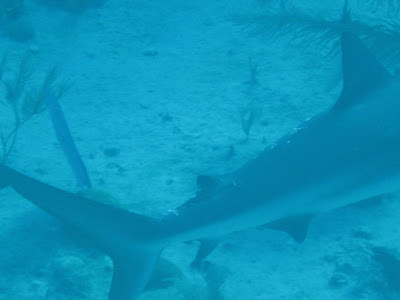It easy to get a little spoiled by the high density of wildlife here. A dive or snorkel where you see a couple Nurse Sharks and a Sting Ray would be considered "just okay." There's so much out there and sightings are so common that it takes quite a bit more to be impressed. This morning was one of those times.
I joined Jan and Will (the SFS interns) on a short snorkel outing to Shark Alley. Jan goes there regularly in search of Eagle Rays for her research on their behavior. And today they did not disappoint. Literally immediately after jumping into the water, we saw the first one. It was probably a little frightened by the boat because it was moving quickly away from us into the shipping channel. We had no hope of keeping up with it for long so we turned around and, soon after, spotted the next two. They were swimming as a pair, and close behind was a large Southern Sting Ray. My guess is that the Sting Ray was just nearby by coincidence, but not much is really known about the behavior of either animal. Jan was able to recognize one of the two paired Eagle Rays, and she hopes to be able to identify the other using her database of photographs. It would be significant if she can confirm that the two have been paired for some period of time, which she thinks is a possibility.
The current was quite strong this morning, so we let ourselves drift for a while back towards the boat, looking around us for more marine life. Soon enough we spotted three Caribbean Reef Sharks! The same three Reef Sharks (two male and one female) we had seen grouped together just two days ago. This time, however, the female had visible bite marks and scratches on her tail, dorsal fin, and side. A couple of the cuts were quite deep. These marks were left by the males who, apparently, had been trying to mate with her for (at least) a couple days. Shark mating behavior is well researched, but actually observing it is quite rare. We watched the larger male actively make an attempt too. He sped forward and bit the female just behind the dorsal fin. There was some struggle and the female managed to get free. Normally when you see sharks they are quite calm and moving slowly. Seeing thrash around to get free was entirely different. I can say that I hope I never end up in that female shark's shoes (fins?). We watched them for a several minutes and they seem pretty unconcerned by our presence. Then one of the males became a little curious, and circled around us about 270°. This made us all a little nervous and we lessened the distance between us, each of us attempting to hide behind the others! The whole time, the shark was tilted slightly, looking upward at us. It didn't act aggressively. It just wanted to know what we were up to. Sharks have a bad reputation, but as we learned from one of this week's movies, more people are killed by vending machines each year than by sharks.
After the sharks left us, we saw two more Sting Rays. One was a juvenile, and the other was another big one, but it was a lighter, almost yellow, color (but a Southern Sting Ray nonetheless). They swam right under a small school of Barracuda (I counted seven). The Barracuda were all small, but it was the first time I've seen so many together. The larger ones seem to be solitary. Our ID book affirms this observation, and it also says that they can swim at speeds reaching 30 feet per second when attacking prey!
We were "knackered" (British for exhausted) from swimming around in such a strong current, so we headed back to the boat. As soon as we got out of the water, however, we could see another ray off the stern. Will and I jumped back in to see what type it was. It was another Southern Sting Ray. Although, it was completely missing its tail, so I guess it was more of a "Stingless" Ray. It's not unusual to see them and Eagle Rays missing their tails, but I don't know how they lose them or if they can grow them back. There's one Sting Ray at the south end of Long Cay with a broken tail that I've seen just about every time I've been there. We watched this Sting Ray for a few seconds before we heard Jan call out to us. We looked up, and she was pointing directly behind us. It was another Eagle Ray! It must have been scared by the way we suddenly turned and started swimming at it because it didn't stick around. Will followed it for a while and said he was impressed at how quickly it moved and how agilely it turned.
In all, we saw 4 Eagle Rays, 4 Sting Rays, 3 Reef Sharks, and a small school of Barracuda - all in a matter of about 25 minutes. I'd say it was a pretty eventful morning!
Subscribe to:
Post Comments (Atom)







No comments:
Post a Comment